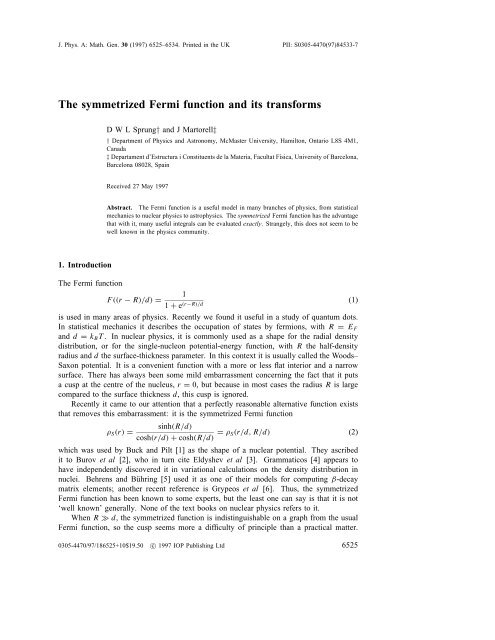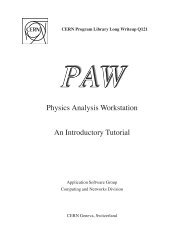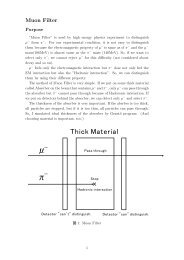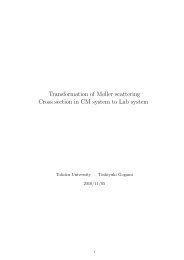The symmetrized Fermi function and its transforms
The symmetrized Fermi function and its transforms
The symmetrized Fermi function and its transforms
You also want an ePaper? Increase the reach of your titles
YUMPU automatically turns print PDFs into web optimized ePapers that Google loves.
J. Phys. A: Math. Gen. 30 (1997) 6525–6534. Printed in the UK PII: S0305-4470(97)84533-7<br />
<strong>The</strong> <strong>symmetrized</strong> <strong>Fermi</strong> <strong>function</strong> <strong>and</strong> <strong>its</strong> <strong>transforms</strong><br />
D W L Sprung† <strong>and</strong> J Martorell‡<br />
† Department of Physics <strong>and</strong> Astronomy, McMaster University, Hamilton, Ontario L8S 4M1,<br />
Canada<br />
‡ Departament d’Estructura i Constituents de la Materia, Facultat Física, University of Barcelona,<br />
Barcelona 08028, Spain<br />
Received 27 May 1997<br />
Abstract. <strong>The</strong> <strong>Fermi</strong> <strong>function</strong> is a useful model in many branches of physics, from statistical<br />
mechanics to nuclear physics to astrophysics. <strong>The</strong> <strong>symmetrized</strong> <strong>Fermi</strong> <strong>function</strong> has the advantage<br />
that with it, many useful integrals can be evaluated exactly. Strangely, this does not seem to be<br />
well known in the physics community.<br />
1. Introduction<br />
<strong>The</strong> <strong>Fermi</strong> <strong>function</strong><br />
1<br />
F ((r − R)/d) =<br />
(1)<br />
1 + e (r−R)/d<br />
is used in many areas of physics. Recently we found it useful in a study of quantum dots.<br />
In statistical mechanics it describes the occupation of states by fermions, with R = E F<br />
<strong>and</strong> d = k B T . In nuclear physics, it is commonly used as a shape for the radial density<br />
distribution, or for the single-nucleon potential-energy <strong>function</strong>, with R the half-density<br />
radius <strong>and</strong> d the surface-thickness parameter. In this context it is usually called the Woods–<br />
Saxon potential. It is a convenient <strong>function</strong> with a more or less flat interior <strong>and</strong> a narrow<br />
surface. <strong>The</strong>re has always been some mild embarrassment concerning the fact that it puts<br />
a cusp at the centre of the nucleus, r = 0, but because in most cases the radius R is large<br />
compared to the surface thickness d, this cusp is ignored.<br />
Recently it came to our attention that a perfectly reasonable alternative <strong>function</strong> exists<br />
that removes this embarrassment: it is the <strong>symmetrized</strong> <strong>Fermi</strong> <strong>function</strong><br />
sinh(R/d)<br />
ρ S (r) =<br />
cosh(r/d) + cosh(R/d) = ρ S(r/d, R/d) (2)<br />
which was used by Buck <strong>and</strong> Pilt [1] as the shape of a nuclear potential. <strong>The</strong>y ascribed<br />
it to Burov et al [2], who in turn cite Eldyshev et al [3]. Grammaticos [4] appears to<br />
have independently discovered it in variational calculations on the density distribution in<br />
nuclei. Behrens <strong>and</strong> Bühring [5] used it as one of their models for computing β-decay<br />
matrix elements; another recent reference is Grypeos et al [6]. Thus, the <strong>symmetrized</strong><br />
<strong>Fermi</strong> <strong>function</strong> has been known to some experts, but the least one can say is that it is not<br />
‘well known’ generally. None of the text books on nuclear physics refers to it.<br />
When R ≫ d, the <strong>symmetrized</strong> <strong>function</strong> is indistinguishable on a graph from the usual<br />
<strong>Fermi</strong> <strong>function</strong>, so the cusp seems more a difficulty of principle than a practical matter.<br />
0305-4470/97/186525+10$19.50 c○ 1997 IOP Publishing Ltd 6525
6526 D W L Sprung <strong>and</strong> J Martorell<br />
However, if R <strong>and</strong> d are comparable, this is not at all so. In any case, it is an advantage<br />
to deal with a <strong>function</strong> for which one can derive analytic results.<br />
<strong>The</strong> model appears to have been invented by Eldyshev et al [3], to describe the nuclearcharge<br />
distribution. <strong>The</strong>y gave the exact form factor<br />
G(q) = 4π<br />
Nq<br />
∫ ∞<br />
0<br />
sin(qr)ρ S (r)r dr<br />
= 3 q 3 πqd<br />
sinh πqd<br />
[ πqd<br />
tanh πqd sin(qR) − qR cos(qR) ]<br />
1<br />
R(R 2 + π 2 d 2 )<br />
where 1/N is the normalization factor that gives a volume integral of unity:<br />
N = 4π 3 R(R2 + π 2 d 2 ). (4)<br />
<strong>The</strong>se results can be checked easily by contour-integral methods (see section 4). By<br />
exp<strong>and</strong>ing G(q) in powers of q 2 one can extract the values of all the even moments of the<br />
charge distribution. One wonders why this has not been common knowledge up until now<br />
Further, one wonders what is the relation between these exact results <strong>and</strong> the well known<br />
Sommerfeld lemma [7] which has traditionally been used to evaluate moments of the <strong>Fermi</strong><br />
<strong>function</strong><br />
<strong>The</strong> purpose of this note is to explore these questions. It is convenient to start with<br />
a paper of Blankenbecler [8], who derived a clever operator expression for integrals over<br />
the <strong>Fermi</strong> <strong>function</strong>. We see that when this is applied to the <strong>symmetrized</strong> <strong>Fermi</strong> <strong>function</strong><br />
equation (2), Blankenbecler’s derivation becomes exact. Otherwise, he had dropped a term<br />
which generates a complicated series of small corrections, that were explored at length<br />
by Maximon <strong>and</strong> Schrack [9]. In Elton’s famous book on nuclear sizes [10] the same<br />
corrections were dropped. <strong>The</strong>refore the ‘approximate’ results obtained by many authors<br />
for the usual <strong>Fermi</strong> <strong>function</strong> are in fact exact results for the <strong>symmetrized</strong> <strong>Fermi</strong> <strong>function</strong>.<br />
As a result, many calculations have actually used the latter, without knowing what they<br />
were doing.<br />
(3)<br />
2. Blankenbecler’s method<br />
First we check that equation (2) can be written as a <strong>symmetrized</strong> <strong>Fermi</strong> <strong>function</strong>.<br />
ρ S (r) =<br />
=<br />
=<br />
1<br />
1 + e + 1<br />
(r−R)/d<br />
1<br />
1 + e − 1<br />
(r−R)/d<br />
1 + e −(r+R)/d − 1<br />
1 + e (r+R)/d<br />
sinh(R/d)<br />
cosh(r/d) + cosh(R/d) . (5)<br />
Note that when r = 0, the value is tanh(R/2d), while when r = R, itis0.5 tanh(R/d).<br />
<strong>The</strong> ratio is<br />
ρ S (R)<br />
ρ S (0) = 1<br />
1 + tanh 2 (6)<br />
(R/2d)<br />
which is close to 0.5 when R ≫ 2d. Hence R is the ‘half-density radius’ at least as much<br />
as it is for the usual <strong>Fermi</strong> <strong>function</strong>. Being an even <strong>function</strong> of r, ρ S (r) has zero slope at<br />
the origin, <strong>and</strong> therefore no cusp, avoiding the defect of the usual <strong>Fermi</strong> <strong>function</strong>.
Symmetrized <strong>Fermi</strong> <strong>function</strong> 6527<br />
In general,<br />
−1 dρ S (r)<br />
= ρ S(r) sinh r/d<br />
(7)<br />
ρ S (r) dr d sinh R/d<br />
which is approximately 1/2d at r = R, when R ≫ d. <strong>The</strong>refore, it is still reasonable to<br />
refer to d as the ‘surface thickness parameter’.<br />
In Blankenbecler’s approach, integrals over the usual <strong>Fermi</strong> <strong>function</strong> equation (1) are<br />
put in dimensionless form, with x = r/d, <strong>and</strong> y = R/d.<br />
1 dF(x)<br />
F(x −y) =<br />
≡ f(x). (8)<br />
1 + e x−y dx<br />
Take a general weight <strong>function</strong> h(x) <strong>and</strong> consider the integral<br />
I =<br />
∫ ∞<br />
This we integrate by parts, writing<br />
so that<br />
0<br />
H(x) =<br />
I =−<br />
=−<br />
h(x)F (x − y)dx. (9)<br />
∫ x<br />
0<br />
∫ ∞<br />
0<br />
∫ ∞<br />
−y<br />
h(x ′ ) dx ′ (10)<br />
H(x)f(x −y)dx<br />
H(x ′ +y)f(x ′ )dx ′ . (11)<br />
<strong>The</strong> boundary term vanishes at the origin by choice of H , <strong>and</strong> at ∞ due to the <strong>Fermi</strong><br />
<strong>function</strong>. Blankenbecler then made the usual approximation of extending the lower limit to<br />
−∞, considering that y = R/d is generally a large value. In the case of the <strong>symmetrized</strong><br />
<strong>Fermi</strong> <strong>function</strong>, this approximation is unnecessary, because there is a second piece of<br />
ρ S (x, y) = F(x − y) − F(x + y) to be considered. In it the sign of y is reversed so<br />
one has the additional contribution<br />
∫ ∞<br />
J =− H(x ′ −y)f(x ′ )dx ′<br />
=<br />
=<br />
y<br />
∫ −∞<br />
−y<br />
∫ −y<br />
−∞<br />
H(−x ′ −y)f(−x ′ )dx ′<br />
H(x ′ +y)f(x ′ )dx ′ . (12)<br />
In the third line we have used the fact that the derivative of the <strong>Fermi</strong> <strong>function</strong> is even:<br />
f(−x) = f(x), <strong>and</strong> we have taken h(x) to be even so that H(x) is odd. For this restricted<br />
class of weight <strong>function</strong>s<br />
∫ ∞<br />
0<br />
h(x)ρ S (x, y) dx = I − J =−<br />
∫ ∞<br />
−∞<br />
H(x ′ +y)f(x ′ )dx ′ . (13)<br />
Hence, Blankenbecler’s argument is exact, but it applies to the <strong>symmetrized</strong> <strong>Fermi</strong> <strong>function</strong>,<br />
<strong>and</strong> only for even weight <strong>function</strong>s. <strong>The</strong> trick now is to write Taylor’s theorem in the form<br />
H(y + x ′ ) = e x′D H(y), where D is the derivative operator acting on H(y). Changing<br />
variables to η = e x′ gives<br />
I S =<br />
∫ ∞<br />
0<br />
η D<br />
dηH (y). (14)<br />
(1 + η)<br />
2
6528 D W L Sprung <strong>and</strong> J Martorell<br />
<strong>The</strong> integral may be evaluated formally by supposing that D is a small number |D| < 1,<br />
putting a branch point at the origin. <strong>The</strong> integr<strong>and</strong> then has a cut along the positive real<br />
axis <strong>and</strong> a double pole at −1. Choosing the keyhole contour to exclude the cut, <strong>and</strong> using<br />
Cauchy’s theorem gives<br />
I S =<br />
πD H(y). (15)<br />
sin πD<br />
This is a very compact result, which is completely equivalent to Sommerfeld’s method (see<br />
appendix A).<br />
More generally, when the weight <strong>function</strong> h(x) is odd, the neglected ‘small correction<br />
terms’ (see appendix B) due to the integral J will be doubled in size when applied to<br />
the <strong>symmetrized</strong> <strong>Fermi</strong> <strong>function</strong>, as compared with the usual <strong>Fermi</strong> <strong>function</strong>. However,<br />
providing that they really are negligible, the result is still useful.<br />
3. Applications<br />
<strong>The</strong> simplest case is for the normalization integral, for which we choose<br />
H(y) = y3<br />
with H ′′ (y) = 2y. (16)<br />
3<br />
When we exp<strong>and</strong> the operator in equation (15) in powers of D, only even powers occur.<br />
Hence only these two derivatives contribute, giving<br />
∫ ∞<br />
ρ S (x)x 2 dx =<br />
R<br />
0<br />
3d 3 [R2 + π 2 d 2 ]. (17)<br />
<strong>The</strong> d 3 is removed as a common factor on both sides of the equation, <strong>and</strong> a 4π is added<br />
for integration over angles, which then verifies equation (4). Similarly, using<br />
H(y) = y5<br />
H ′′ (y) = 4y 3 H (4) (y) = 24y (18)<br />
5<br />
we obtain the mean square radius<br />
〈r 2 〉= 1 5 [3R2 + 7π 2 d 2 ]. (19)<br />
Finally, the choice<br />
H(y) = 1 λ sin λy H ′ (y) = cos λy,... (20)<br />
allows us to evaluate the form factor (here, λ = qd). Unlike the first two examples, we can<br />
evaluate the operator in closed form, rather than by the series expansion. We continue this<br />
in the next section.<br />
4. Form factor<br />
<strong>The</strong> nuclear form factor is the Fourier transform of the density distribution (2):<br />
∫ ∞<br />
G(q) = 1 N<br />
= 4π<br />
Nq<br />
= −4π<br />
Nq<br />
0<br />
∫ ∞<br />
0<br />
∂<br />
∂q<br />
e iq·r ρ S (r) d 3 r<br />
sin(qr)ρ S (r)r dr<br />
∫ ∞<br />
0<br />
cos(qr)ρ S (r) dr (21)
Symmetrized <strong>Fermi</strong> <strong>function</strong> 6529<br />
where N normalizes G(q = 0) = 1. We therefore wish to evaluate<br />
K =<br />
∫ ∞<br />
0<br />
cos(λx)ρ S (x, y) dx (22)<br />
where x = r/d, y = R/d <strong>and</strong> λ = qd. Since the integr<strong>and</strong> is even, we can write<br />
∫ ∞<br />
K = 1 2 R e iλx ρ S (x) dx. (23)<br />
−∞<br />
<strong>The</strong> integr<strong>and</strong> has poles at the complex points z =±y+iπ. Consider, therefore, the contour<br />
integral over a rectangle consisting of the real line z = x, the line z = x + 2iπ, <strong>and</strong> two<br />
ends which will be allowed to recede to ±∞. Using Cauchy’s theorem, we find<br />
(1 − e −2λπ )K = πi[e iλ(−y+iπ) −e iλ(y+iπ) ]. (24)<br />
Hence,<br />
π<br />
K = sin qR (25)<br />
sinh πqd<br />
where we have reverted to physical un<strong>its</strong>. By taking the derivative with respect to q we<br />
recover the result given in equation (3).<br />
Now we apply Blankenbecler’s method to the case of equation (20) to obtain the same<br />
result. Only even-order derivatives of H(y) = sin λy/λ are required, <strong>and</strong> one sees that<br />
D 2k H(y) = (−) k λ 2k H(y) (26)<br />
so that the operator D in equation (15) can be consistently replaced by iλ. This avoids<br />
having to sum a series that would otherwise converge only for |λ| < 1. We have<br />
K =<br />
iπλ<br />
sin iπλ H(y) = π<br />
sin qR (27)<br />
sinh πqd<br />
in agreement with the direct evaluation in equation (25).<br />
5. Other Bessel <strong>transforms</strong><br />
In considering models of quantum dots, we have had to deal with the problem of constructing<br />
the potential inside a semiconductor, knowing <strong>its</strong> form at the exposed surface. For cases of<br />
cylindrical symmetry the use of Fourier–Bessel expansions has some advantages over the<br />
more conventional Poisson formula. This lead us to consider the integral<br />
v(q) ≡<br />
∫ ∞<br />
0<br />
ρ S (r/d, R/d)J 0 (qr)r dr. (28)<br />
As before, we use dimensionless variables x = r/d, y = R/d <strong>and</strong> λ = qd. <strong>The</strong>n<br />
∫ ∞<br />
q 2 v(q) = λ 2 ρ S (x, y)J 0 (λx)x dx (29)<br />
0<br />
for which the <strong>function</strong> H(x) = λxJ 1 (λx). Note that this is an even <strong>function</strong> of x, so<br />
Blankenbecler’s method is no longer exact. In fact, the so-called small corrections are<br />
twice as large as for the usual <strong>Fermi</strong> <strong>function</strong>, which can be seen from equations (11) <strong>and</strong><br />
(12). But so long as they are negligible this has little importance (see appendix B for<br />
more discussion). Equation (29) can be evaluated by Blankenbecler’s method as above but<br />
requires a little more ingenuity. <strong>The</strong> result will be expressed using variables z = λy = qR,
6530 D W L Sprung <strong>and</strong> J Martorell<br />
<strong>and</strong> α = λπ = πqd (in this section, z is real). Using now D = d/dz, equation (15)<br />
becomes<br />
q 2 v(q) =<br />
αD H(z). (30)<br />
sin αD<br />
Exp<strong>and</strong>ing in powers of α = πqd, <strong>and</strong> taking the derivatives, one finds for the first few<br />
terms<br />
q 2 v(q) = qRJ 1 (qR) − (πqd)2 [qRJ 1 (qR) − J 0 (qR)]<br />
6<br />
[<br />
+ 7(πqd)4 qRJ 1 (qR) − 2J 0 (qR) + J ]<br />
1(qR)<br />
360<br />
qR<br />
− 31(πqd)6<br />
360(42)<br />
[<br />
qRJ 1 (qR) − 3J 0 (qR) + 3<br />
qR J 1(qR) − 3<br />
(qR) 2 J 2(qR)<br />
]<br />
+···.<br />
(31)<br />
As noted in appendix A, this series diverges for large |α|, so one would like to know <strong>its</strong><br />
sum. Further study reveals that the coefficients involve <strong>function</strong>s<br />
y p (z) ≡ (−) p+1 (2p − 1)!! J p(z)<br />
(32)<br />
z p<br />
with y 0 =−J 0 (z) <strong>and</strong> y −1 ≡ zJ 1 (z). Differentiation is facilitated by the relation<br />
y p ′′ =−y p−y p+1 . (33)<br />
For example, one has<br />
(zJ 1 (z)) ′′ =−zJ 1 (z) + J 0 =−y −1 −y 0 . (34)<br />
At large z, the J 0 term is of relative order 1/z. If we could neglect it altogether, then we<br />
could replace the derivative operator in equation (30) by i since only even powers of D<br />
occur in the expansion. <strong>The</strong> result would be zJ 1 (z)α/ sinh α, as in equation (27).<br />
Taking the derivatives systematically leads to the tableau<br />
−(zJ 1 ) (2) = zJ 1 + y 0<br />
(zJ 1 ) (4) = zJ 1 + 2y 0 + y 1<br />
−(zJ 1 ) (6) = zJ 1 + 3y 0 + 3y 1 + y 2<br />
(35)<br />
(zJ 1 ) (8) = zJ 1 + 4y 0 + 6y 1 + 4y 2 + y 3<br />
−(zJ 1 ) (10) = zJ 1 + 5y 0 + 10y 1 + 10y 2 + 5y 3 + y 4 .<br />
One sees that the rule for carrying out the derivatives generates coefficients according to<br />
Pascal’s triangle, so they are the binomial coefficients l C p . <strong>The</strong> general case is therefore<br />
l∑<br />
(−) l D 2l zJ 1 (z) = lC p y p−1 . (36)<br />
p=0<br />
Following equation (A.3), with c 0 = 1 , we have<br />
2<br />
αD<br />
∞∑<br />
sinh αD = 2 (−) l c 2l α 2l D 2l . (37)<br />
l=0<br />
This gives<br />
∞∑<br />
l∑<br />
q 2 v(q) = 2 (−) l c 2l α 2l<br />
lC p y p−1 . (38)<br />
l=0<br />
p=0
Symmetrized <strong>Fermi</strong> <strong>function</strong> 6531<br />
By reversing the order of summations we have<br />
∞∑ ∞∑<br />
q 2 v(q) = 2<br />
(−) l lC p c 2l α 2l . (39)<br />
p=1<br />
y p−1<br />
p=0 l=p<br />
<strong>The</strong> coefficient of y p−1 can be expressed in closed form if we note from equation (37)<br />
(with D = 1) that<br />
α 2p ( ) ∂ p<br />
α<br />
∞∑<br />
p! ∂α 2 sinh α = (−) l c 2ll C p α 2l . (40)<br />
l=p<br />
Thus,<br />
q 2 α<br />
∞∑<br />
v(q) − zJ 1 (z)<br />
sinh α = 1 ∂ p α<br />
y p−1<br />
p! α2p ∂(α<br />
p=1<br />
2 ) p sinh α<br />
∞∑<br />
( )<br />
1 1 ∂ p<br />
α<br />
= y p−1<br />
2 p p! α2p α ∂α sinh α<br />
)<br />
∂ p<br />
α<br />
∂α sinh α . (41)<br />
∞∑<br />
(<br />
p<br />
(2p − 3)!! J p−1 (z) 1<br />
= (−) α 2p<br />
2<br />
p=1<br />
p p! z p−1 α<br />
We worked out the first few terms of this series explicitly, with the result<br />
q 2 v(q) =<br />
πqd [<br />
qRJ 1 (qR) + 1 ( )<br />
πqd<br />
sinh πqd<br />
2 tanh πqd −1 J 0 (qR)<br />
+ 1 [( )(<br />
) ] 2πqd<br />
πqd<br />
8 tanh πqd +1 tanh πqd −1 −(πqd) 2 J1 (qR)<br />
qR<br />
+ 1 [ ( 2(πqd)<br />
2<br />
3<br />
16 tanh 2 πqd + 2πqd )(<br />
)<br />
πqd<br />
tanh πqd +1 tanh πqd −1<br />
− 5(πqd)3<br />
tanh πqd<br />
× J 2(qR)<br />
(qR) 2 +···]<br />
. (42)<br />
It is seen that α/ sinh α is a common factor, <strong>and</strong> the remaining coefficients become<br />
polynomials in α at large qd, soq 2 v(q) decreases exponentially. <strong>The</strong> coefficients of y p<br />
become more <strong>and</strong> more complicated but one can certainly work them out systematically.<br />
<strong>The</strong> result is an asymptotic series in z, where the dependence on α has been summed. One<br />
is not limited to small qd, as for the Sommerfeld expansion, or equation (31). On the other<br />
h<strong>and</strong>, if equation (42) is exp<strong>and</strong>ed in powers of α, it reproduces exactly equation (31).<br />
In figure 1 we show a log plot of |v(q)| versus q for the case R = 30, d = 1. <strong>The</strong><br />
maxima of |v(q)| vary by 20 orders of magnitude over the range considered, <strong>and</strong> on this<br />
scale the exact (numerical) values cannot be distinguished from expression (42). In figure 2,<br />
we have exp<strong>and</strong>ed a small portion of the drawing, for 2.2
6532 D W L Sprung <strong>and</strong> J Martorell<br />
5<br />
0<br />
log ( |v(q)| )<br />
–5<br />
–10<br />
–15<br />
0 1 2 3 4 5<br />
q<br />
Figure 1. A log plot of |v(q)| for the case R = 30, d = 1.<br />
–4<br />
exact<br />
0th order<br />
–6<br />
log ( |v(q)| )<br />
–8<br />
–10<br />
–12<br />
2.2 2.25 2.3 2.35 2.4<br />
q<br />
Figure 2. Exp<strong>and</strong>ed plot of a portion of figure 1. Full curve, exact; broken curve, leading term<br />
of equation (42).<br />
example, in a very instructive paper, Amado <strong>and</strong> collaborators [11] discussed the <strong>Fermi</strong><br />
<strong>function</strong> as a strong nuclear form factor for nucleon–nucleus scattering. <strong>The</strong>ir approach<br />
closely parallels our direct evaluation, <strong>and</strong> they obtained K of equation (25) by summing<br />
the contributions from the poles of the <strong>Fermi</strong> <strong>function</strong> as we did implicitly in equation (24).<br />
Having a closed form would have simplified their discussion.<br />
In two-dimensional problems such as quantum dots, one requires <strong>transforms</strong> involving<br />
cylinder <strong>function</strong>s. We have given an example where the resulting series works well. By<br />
extending the definition of the y p to negative p, one can do similar integrals involving any<br />
odd power of x times J 0 . <strong>The</strong> dependence on the ‘small’ parameter α = πqd is summed<br />
exactly, while the dependence on the large parameter z = qR is given by an asymptotic<br />
series, but one which reproduces the Taylor series at small α. Calculations presented show<br />
that very good results were obtained in our example.<br />
We therefore expect that this method can be useful in a variety of different contexts,<br />
wherever the <strong>Fermi</strong> <strong>function</strong> finds application.
Acknowledgments<br />
Symmetrized <strong>Fermi</strong> <strong>function</strong> 6533<br />
We are grateful to NSERC Canada for continued support under research grant SAP-003198<br />
(DWLS). <strong>The</strong> work of JM is supported by the grant PB94-0900 from DGES Spain.<br />
Appendix A. Relation to Sommerfeld’s lemma<br />
Here we relate our results to the well known Sommerfeld lemma as outlined by<br />
Ch<strong>and</strong>rasekhar [7], which expresses the integral of equation (9) (approximately) as a series<br />
of terms involving the <strong>function</strong> H(y) of equation (10) <strong>and</strong> <strong>its</strong> even-order derivatives. H(y)<br />
must be sufficiently smooth <strong>and</strong> H(0) = 0. One has<br />
∫ ∞<br />
F(x −y) dH(x)<br />
∑<br />
dx ≈ H(y)+2 c ν H (ν) (y).<br />
(A.1)<br />
0<br />
dx<br />
ν=2,4,6,...<br />
<strong>The</strong> coefficients are (for ν ≠ 0)<br />
c ν = 1 − 1 2 ν + 1 3 ν − 1 4 ν +···.<br />
(A.2)<br />
<strong>The</strong> first few of these sums are<br />
c 2 = π 2<br />
c 4 = 7π 4<br />
12<br />
720<br />
c 6 = 31π 6<br />
···.<br />
30 240<br />
(A.3)<br />
For large ν the coefficients approach unity from below.<br />
Comparing with Blankenbecler’s formula, equation (15), we see that the coefficient c ν<br />
of equation (A.2) can be computed as half the coefficient of D ν in the Taylor expansion of<br />
πD/sin πD. This is undoubtedly the easiest way to generate them. Through this relation<br />
they are closely related to the Bernoulli numbers. <strong>The</strong> general result may be found in<br />
Gradshtein <strong>and</strong> Ryzhik [12]:<br />
πx<br />
∞∑<br />
sinh πx = 1+2 B 2n (2 2n−1 −1) (πx)2n<br />
(2n)!<br />
n=1<br />
(A.4)<br />
from which<br />
c 2n = (−) n+1 B 2n (2 2n−1 − 1) (π)2n<br />
(2n)! .<br />
(A.5)<br />
For reference,<br />
B 2 = 1 6<br />
Appendix B. Error term<br />
B 4 = −1<br />
30<br />
B 6 = 1 ···. (A.6)<br />
42<br />
If one deals with the un<strong>symmetrized</strong> <strong>Fermi</strong> <strong>function</strong>, then the integral I of equation (9)<br />
lacks the second piece of ρ S (x, y) = F(x − y) − F(x + y). This induces an error (see<br />
equation (13))<br />
∫ ∞<br />
h(x)<br />
J =<br />
dx<br />
0 1 + ex+y =− ∑ ∫ ∞<br />
(−) p e −py e −px h(x) dx.<br />
(B.1)<br />
p=1<br />
0
6534 D W L Sprung <strong>and</strong> J Martorell<br />
In the particular case at h<strong>and</strong>, h(x) = xJ 0 (λx), the integral is known [12]<br />
∫ ∞<br />
xe −px p<br />
J 0 (λx) dx =<br />
. (B.2)<br />
0<br />
(p 2 + λ 2 )<br />
3/2<br />
Hence,<br />
J =− ∑ (−) p e −py p<br />
(p<br />
p=1<br />
2 + λ 2 ) 3/2<br />
=− ∑ (−) p e −pR/d p<br />
. (B.3)<br />
(p<br />
p=1<br />
2 + q 2 d 2 )<br />
3/2<br />
Since this is an alternating series of positive terms, the sum is less than the first term, <strong>and</strong><br />
greater than the difference of the first two.<br />
(<br />
e −R/d 1<br />
(1 + q 2 d 2 ) J 1<br />
3/2 e−R/d 1 − e −R/d 2(1 + q2 d 2 ) 3/2 )<br />
. (B.4)<br />
(1 + q 2 d 2 ) 3/2 (4 + q 2 d 2 ) 3/2<br />
<strong>The</strong> magnitude of the error is set by e −R/d , <strong>and</strong> when R ≫ d this is bound to be small.<br />
However, as a <strong>function</strong> of qd, it decreases only as the inverse third power, so asymptotically<br />
this will overtake the expansion given in equation (42). For the values adopted in figure 1,<br />
this will only show up at much larger values of qd.<br />
References<br />
[1] Buck B <strong>and</strong> Pilt A A 1977 Nucl. Phys. A 280 133–60<br />
[2] Burov V V, Ivanyuk F A <strong>and</strong> Konstantinov B D 1975 Yad. Fiz. 22 1142–5<br />
[3] Eldyshev Yu N, Lukanyov V N <strong>and</strong> Pol’ Yu S 1972 Yad. Fiz. 16 506–14<br />
[4] Grammaticos B 1982 Z. Phys. A 305 257–62<br />
[5] Behrens H <strong>and</strong> Büring W 1982 Electron Radial Wave Functions <strong>and</strong> Nuclear Beta Decay (Oxford: Clarendon)<br />
pp 128–9<br />
[6] Grypeos M E, Lalazissis G A, Massen S E <strong>and</strong> Panos C P 1991 J. Phys. G: Nucl. Part. Phys. 17 1093–104<br />
[7] Ch<strong>and</strong>rasekhar S 1967 Stellar Structure (New York: Dover) pp 389–91<br />
[8] Blankenbecler R 1957 Am. J. Phys. 25 279–80<br />
[9] Maximon L C <strong>and</strong> Schrack R A 1966 J. Res. NBS B 70 85–94<br />
[10] Elton LRB1961 Nuclear Sizes (Oxford: Oxford University Press) pp 106–7<br />
[11] Amado R D, Dedonder J P <strong>and</strong> Lenz F 1980 Phys. Rev. C 21 647–61<br />
[12] Gradshteyn I S <strong>and</strong> Ryzhik I M 1965 Table of Integrals Series <strong>and</strong> Products (New York: Academic)<br />
equation 1.411.12, p 35 <strong>and</strong> equation 6.611.1, p 707









